2. 浏阳市自然资源局, 浏阳 410300;
3. 贵州省地质矿产勘查开发局一〇六地质大队, 遵义 563000;
4. 核工业航测遥感中心, 石家庄 050000
2. Natural Resources Bureau, Liuyang 410300, China;
3. 106 Geological Party of Guizhou Geological Mineral Exploration Development Authority, Zunyi 563000, China;
4. Airborne Survey and Remote Sensing Center of Nuclear Industry, Shijiazhuang 050000, China
钨是洁净能源、信息产业、航天航空和国家安全等许多重要高新技术领域不可或缺的战略性关键矿产(蒋少涌等,2019;翟明国等,2019)。同时,钨矿床作为我国传统的优势金属矿产之一,前人也对其作了大量的概括性总结,包括我国钨锡矿床的时空分布规律、大地构造特征、成因类型、成矿机制和成矿规律及资源潜力等方面(Hu and Zhou, 2012; Mao et al., 2013, 2020, 2021; 盛继福等, 2015; 袁顺达, 2017; 夏庆霖等, 2018; 蒋少涌等, 2020; 毛景文等, 2020)。另外,在钨成矿理论方面也有一些新的进展:Xie et al. (2019)在湘中地区发现了一种世界上罕见的远端还原性矽卡岩型钨矿;Liu et al. (2018)在东南沿海成矿带新发现了斑岩型锡矿;Yuan et al. (2019)提出了原岩及熔融温度差异可能是导致成钨还是成锡的原因之一;Xiong et al. (2020a)认为华南地区可能存在多期次的钨锡成矿作用,指出白云母花岗岩是华南地区钨锡找矿的新目标。因此,在前人工作基础上,进一步厘定钨矿床的成矿时代、确定矿床成因、进而找到成矿母岩,对当前钨矿勘查工作的有效开展极为重要。
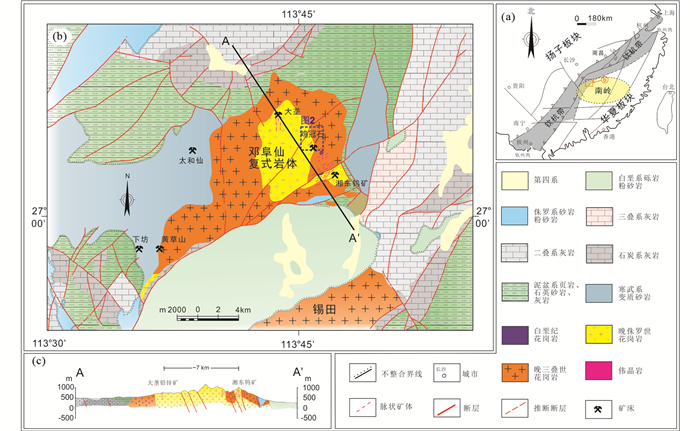
|
图 1 邓阜仙矿田位置图(a,据杨明桂等,2009修改)和区域地质图(b,据Xiong et al., 2020b修改) Fig. 1 Location of Dengfuxian orefield (a, modified after Yang et al., 2009) and regional geological map of the Dengfuxian orefield (b, modified after Xiong et al., 2020b) |
鸡冠石钨矿床是近年湖南邓阜仙地区新发现的一处钨矿床(图 1),具有良好的钨锡多金属资源前景(湖南省地质矿产勘查开发局四一六队, 2011①)。该矿床紧邻邓阜仙地区湘东钨矿床北组脉和金竹垄铌钽矿床,围岩为晚三叠世粗中粒黑云母花岗岩和晚侏罗世细粒二云母花岗岩,在金竹垄矿床附近出露有白云母花岗岩。该地区出露的邓阜仙花岗岩为南岭地区一典型的复式花岗岩体,由晚三叠世、晚侏罗世和早白垩世花岗岩组成,每一期次的岩浆活动可能还存在从黑云母花岗岩-二云母花岗岩-白云母花岗岩的演化序列(蔡杨等,2013;黄卉等,2013;何苗等,2018),同时该地区还存在相应的晚侏罗世和早白垩世多期次钨锡成矿作用(Li et al., 2019; Xiong et al., 2020a)。虽然鸡冠石矿床与湘东钨矿床具有紧密的空间联系,但其成矿时代尚不清楚,矿床成因和成矿母岩也未明确,因此也限制了该矿勘查工作的部署。
① 湖南省地质矿产勘查开发局四一六队.2011.湖南锡田地区锡铅锌多金属矿勘查报告
锡石是钨锡矿床中常见的伴生矿物,同时在铌钽锂铍等稀有金属矿床中也经常出现。随着定年技术的不断发展,锡石U-Pb定年已经逐渐成为钨锡稀有金属矿床研究中确定成矿时代重要的方法之一(刘玉平等,2007;Yuan et al., 2008, 2011; 王小娟等, 2014; Zhang et al., 2015, 2017a, b; Li et al., 2016; Cao et al., 2017, 2021; Guo et al., 2018a, b; Fei et al., 2020; 李杭等,2020)。黑钨矿是钨矿床中重要的经济矿物,随着原位测试技术的不断发展,黑钨矿原位微量元素成分研究也越来越多地应用到钨矿床的成因研究中(Goldmann et al., 2013; Xiong et al., 2017, 2020a; Harlaux et al., 2018; Zhang et al., 2018)。因此,本文选取鸡冠石钨矿床为研究对象,在详细的地质观察基础上,对比相邻矿床的地质特征,并通过对鸡冠石钨矿床中黑钨矿进行原位LA-ICP-MS微量元素分析和锡石U-Pb定年研究,以期确定其形成时代和矿床成因,为找矿勘查提供指示。
1 矿田地质特征邓阜仙矿田位于湖南省茶陵东北部,郴州-茶陵北东向钨锡多金属成矿区带北东段(图 1a),是南岭成矿带和钦杭成矿带的重要组成部分。区内出露地层主要为寒武到石炭系变质砂岩、灰岩等浅变质沉积岩,其次为二叠系到第四系砂岩和灰岩等沉积碎屑岩。邓阜仙地区自中生代以来历经了加里东期、海西期、印支期、燕山期及喜山期等多期构造岩浆旋回活动,区域构造复杂交织,挤压隆起与拉张断陷相间作用,不同期次形成的构造变形相互叠合、改造。区内岩浆活动频繁,火成岩体发育广泛并以中生代酸性侵入为主。
研究区内还发育有一条醒目的NE向大断裂――茶汉断裂。通过野外调研及镜下观察,发现该断裂具有多期活动的特征(Wei et al., 2018)。第一期为成矿期正断层,同时伴随大规模的热液硅化,地表见30m宽的硅化带,断层岩镜下特征显示硅化蚀变强烈,硅化角砾被后期石英细脉穿插;第二期为成矿后的挤压活动,断层泥发育,并以其分支断裂老山坳断层为代表;第三期为大规模的伸展滑脱正断层,对应于区域伸展高峰期,控制了白垩纪红层盆地沉积。
矿区出露的岩体为邓阜仙花岗岩体,为一多期次多阶段侵入的复式岩体,总面积约为171km2。前人通过野外接触关系、岩相学和同位素定年等方法,将邓阜仙岩体划分为三个期次:第一期为印支期中粗粒斑状黑云母花岗岩,为A型花岗岩(225.7±1.6Ma,Cai et al., 2015),分布在复式岩体的四周,呈似马蹄形,构成了复式岩体的主体,面积约为130km2;第二期燕山期中粒二云母花岗岩,S型(154.4±2.2Ma,黄卉等,2013),呈岩株状出露于邓阜仙复式岩体的中部、东南部及西南部边缘,侵入于第一期的黑云母花岗岩中;第三期为细粒白云母花岗岩,S型(~142Ma,Xiong et al., 2020a),地表露头较少,以小岩株和岩脉的形式穿插到前两期花岗岩中。除此之外,在邓阜仙矿区,也有少量基性煌斑岩呈脉状侵入在中细粒二云母花岗岩中。煌斑岩脉多为北东走向,为早白垩世形成(143~141Ma,Liu et al., 2020a)。
本区矿产较为丰富,有铅、锌、铜等有色金属及钨、锡、铌、钽等稀有金属。前人研究表明,该区钨锡与铅锌等多金属矿化可能为同一岩浆热液成矿系统的产物(Xiong et al., 2019, 2020b; Liu et al., 2020b)。
2 矿床地质特征鸡冠石矿床地处茶陵县城北东约50km,属茶陵县八团乡管辖,位于湘东钨矿外围北部,区内无地层出露。矿区断裂构造发育,南东部出露区域性茶(陵)-汉(背)断裂,性质为逆断层,走向NE,倾向SE,倾角40°左右,为区内钨多金属矿的导矿构造,其次级平行NE向压扭性断裂构造密集发育,且为本区的容矿构造。赋矿岩浆岩为印支期粗中粒黑云母花岗岩和燕山早期细粒二云母花岗岩。
已发现石英脉或构造蚀变岩型(6号矿脉)钨多金属矿脉15条,其中规模较大的矿脉5条,矿脉呈密集的脉状成组成带分布(图 2),走向NE,倾向SE(局部倾向NW),倾角较陡,一般65°~85°。单脉走向长430~2300m,一般1300m左右,矿体厚0.56~3.23m,单脉平均品位WO30.06%~1.418%,Sn 0.003%~ 0.214%。其中6号矿脉中深部经ZK001、ZK002、ZK301、ZK401、ZK701、ZK801钻孔控制,见矿情况较好。控制矿体倾向延深约230~500m。但是大部分矿脉的围岩包括印支期粗中粒黑云母花岗岩和燕山早期细粒二云母花岗岩两种,成矿母岩尚未确定。
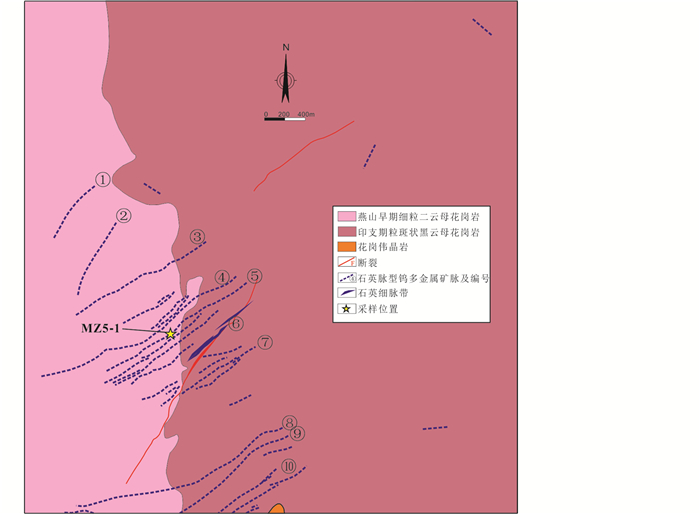
|
图 2 鸡冠石钨矿床地质图 Fig. 2 Geological map of the Jiguanshi tungsten deposit |
含钨石英脉常呈平行条带状、网脉状产出,其中的主要金属矿物为黑钨矿、白钨矿、黄铁矿、磁黄铁矿、毒砂、黄铜矿、闪锌矿和方铅矿等(图 3),少量的锡石和菱铁矿。脉石矿物以石英为主,少量长石、白云母、绢云母、电气石、萤石和方解石,矿物组合指示其高中温成矿的特征。矿石结构以他形-自形粒状结构、交代残余结构为主。矿石构造主要以条带状、浸染状构造为主。围岩蚀变主要有云英岩化、绢云母化、绢英岩化、电气石化、硅化、绿泥石化、叶腊石化等。
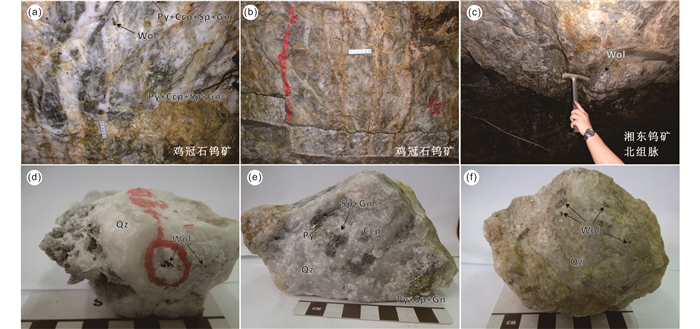
|
图 3 鸡冠石钨矿床矿体及矿石照片 (a、b)鸡冠石钨矿床中矿体特征;(c)湘东钨矿床北组脉矿体特征;(d、f)鸡冠石矿床钨矿石;(e)鸡冠石矿床硫化物矿石. Py-黄铁矿;Ccp-黄铜矿;Sp-闪锌矿;Gn-方铅矿;Wol-黑钨矿;Qz-石英 Fig. 3 Photos of orebodies in the Jiguanshi W deposit (a, b) features of orebodies in the Jiguanshi deposit; (c) feature of orebody from north vein group in the Xiangdong W deposit; (d, f) tungsten ores in the Jiguanshi deposit; (e) sulfides ore in the Jiguanshi deposit. Py-pyrite; Ccp-chalcopyrite; Sp-sphalerite; Gn-galena; Wol-wolframite; Qz-quartz |
通过野外和显微镜下对矿脉的穿插关系、矿物共生组合关系的观察,可将鸡冠石钨矿的成矿作用划为3个阶段。
Ⅰ阶段:黑钨矿+锡石+毒砂+石英;所观测到的锡石常与黑钨矿紧密共生(图 4a),大小0.05~1cm;毒砂呈半自形,较破碎;上述矿物均产出于石英脉中。
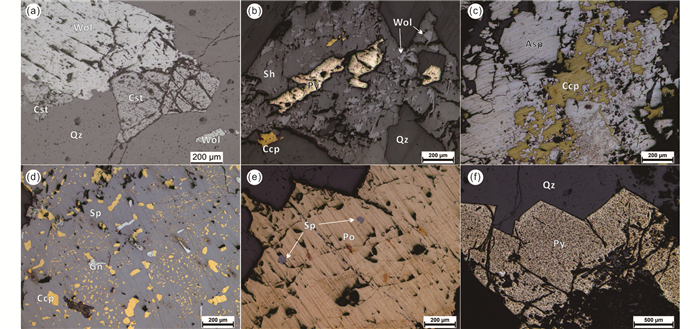
|
图 4 鸡冠石钨矿床矿物镜下特征 (a)锡石与黑钨矿共生;(b)黑钨矿与白钨矿、黄铜矿、黄铁矿共生;(c)毒砂与黄铜矿共生;(d)闪锌矿与方铅矿和黄铜矿共生;(e)磁黄铁矿与闪锌矿共生;(f)石英脉中自形黄铁矿. Cst-锡石;Sh-白钨矿;Asp-毒砂;Po-磁黄铁矿 Fig. 4 Photomicrographs of the ores from the Jiguanshi W deposit (a) cassiterite coexists with wolframite; (b) wolframite coexists with scheelite, chalcopyrite and pyrite; (c) arsenopyrite coexists with chalcopyrite; (d) sphalerite coexists with galena and chalcopyrite; (e) pyrrhotite coexists with sphalerite; (f) euhedral pyrite coexists with quartz. Cst-cassiterite; Sh-scheelite; Asp-arsenopyrite; Po-pyrrhotite |
Ⅱ阶段:黑钨矿+白钨矿+黄铁矿+黄铜矿+毒砂+石英;白钨矿普遍呈不规则状分布,显微镜下比黑钨矿颜色更深,熔蚀并包裹了早期的黑钨矿(图 4b);黄铜矿呈不规则状产出,与黄铁矿、毒砂等矿物共生,常充填于Ⅰ阶段的黑钨矿中(图 4b,c);毒砂呈自形-半自形,多以团包状产出与石英脉中;与早期毒砂相比,表面较光滑,常与黄铜矿等共生(图 4c)。脉石矿物主要为石英。
Ⅲ阶段:黄铁矿+黄铜矿+闪锌矿+方铅矿+磁黄铁矿+石英;黄铜矿以不规则状或固溶体形式与闪锌矿、方铅矿、磁黄铁矿和毒砂共生(图 4d),熔蚀了早期的毒砂;磁黄铁矿分布较少,以不规则状产出于闪锌矿中,并与黄铜矿共生(图 4e);该阶段黄铁矿较自形(图 4f)。脉石矿物主要为石英。
3 样品采集及测试方法本次进行分析的样品采自鸡冠石矿区5号矿脉,具体位置见图 2。挑选野外采集到的典型样品进行磨制探针片和挑选锡石单矿物并制成环氧树脂靶,在详细显微观察的基础上(包括显微镜和CL照相),选取包裹体少、裂隙少的锡石进行LA-ICP-MS U-Pb定年分析。锡石LA-ICP-MS U-Pb同位素定年的分析在中国地质大学(武汉)地质过程与矿产资源国家重点实验室(GPMR)矿床地球化学分室完成。电感耦合等离子体质谱仪(ICP-MS)型号为赛默飞公司的iCAP Qc,同时配以瑞索公司RESOlution-S155 193nm ArF准分子激光器。实验用载气为高纯氦气,同时辅以氩气和少量氮气混合后进入质谱仪。样品分析测试之前,用直径50μm的束斑,5μm/s的速度对NIST SRM 612进行线形剥蚀以调谐仪器条件至最优。LA-ICP-MS锡石U-Pb同位素定年过程中将NIST SRM 612用以信号漂移矫正,同时锡石标准AY-4(206Pb/238U ID-TIMS年龄158.2 ± 0.4Ma,Yuan et al., 2011)作为外标进行元素分馏校正。样品测试的激光束斑直径为33μm,剥蚀频率为5Hz,能量密度为6J/cm2,离子检测器接收条件为:238U、232Th、208Pb、206Pb、204Pb接收20ms;207Pb接收40ms。每测定10个未知样品点,交替2次AY-4和1次NIST SRM 612的测试,每一个点位的测定需要进行30s的空白背景接收、40s的激光剥蚀及信号接收和60s的样品池和管道清洗程序。年龄图解的制作运用Isoplot 4.1(Ludwig, 2012),分析误差为2σ。将实验数据做Tera-Wasserburg图解(Tera and Wasserburg, 1972)得到的纵轴交点即为普通铅207Pb/206Pb的比值,下交点年龄即为锡石的形成年龄。将得到的普通铅207Pb/206Pb扣除后计算可得普通铅校正后的206Pb/238U年龄,可计算加权平均年龄。
原位LA-ICP-MS黑钨矿微量分析在武汉上谱分析科技有限责任公司完成,LA系统为GeoLas 2005,ICP-MS分析使用的仪器为Agilent 7700e。实验用载气为高纯氦气,同时辅以氩气来调整激光剥蚀过程中仪器的灵敏度,载气在T型交换机中充分混合后再进入质谱仪(Zhang et al., 2017)。每一个点位的测定需要进行20~30s的空白背景接收和50s的激光剥蚀及信号接收。本次微量元素测试采用无内标和多外标的方法进行结果校正,外标为USGS的BCR-2G、BIR-1G和BHVO-2G玻璃标样(Zhang et al., 2020)。USGS玻璃标样的详细数据可参考网站数据库(http://georem.mpch-mainz.gwdg.de/)。详细的仪器操作条件、操作过程及数据处理参考Xiong et al.(2017)。
4 分析结果锡石LA-ICP-MS U-Pb测试结果和原位黑钨矿LA-ICP-MS分析的结果分别列于表 1和表 2,黑钨矿微量元素单点分析误差见电子版附表 1。
|
|
表 1 鸡冠石钨矿床锡石LA-ICP-MS U-Pb测试结果 Table 1 The result of cassiterite LA-ICP-MS U-Pb dating in the Jiguanshi deposit |
|
|
表 2 鸡冠石矿床黑钨矿微量元素组成(×10-6) Table 2 Trace element composition of wolframite in the Jiguanshi deposit (×10-6) |
|
|
附表 1 鸡冠石矿床黑钨矿微量元素单点分析误差(×10-6) AttachedTable1 Analytical error of trace element composition of wolframite in the Jiguanshi deposit (×10-6) |
含黑钨矿锡石样品MZ5-1中的锡石颗粒绝大多数粒径大于150μm,且CL图像下可以看到清晰的环带,偶见流体扰动的CL环带(图 5),部分裂隙发育,在透射光下可见有较少的流体包裹体。本次测试共有18个有效测点,得到Tera-Wasserburg下交点年龄为153.2±1.8Ma (MSWD=1.15,N=18),206Pb /238U加权平均年龄为153.0±1.7Ma (MSWD=1.2,图 5)。
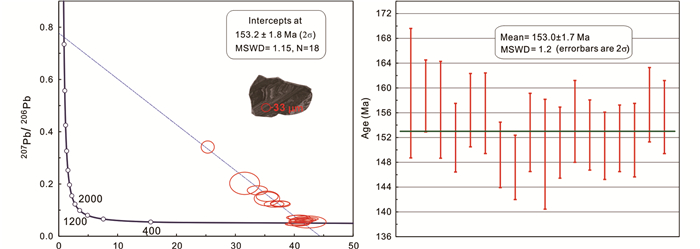
|
图 5 锡石LA-ICP-MS U-Pb定年结果 Fig. 5 Plots of cassiterite LA-ICP-MS U-Pb dating |
鸡冠石矿床黑钨矿中微量元素主要有Nb、Ta、Sc、Co、Cu、Zn等,其中Nb含量为215×10-6~853×10-6,平均528×10-6;Ta含量为12×10-6~126×10-6,平均50×10-6;Sc含量为2×10-6~13×10-6,平均6×10-6;Zn含量为14×10-6~133×10-6,平均64×10-6;Sn含量为4×10-6~46×10-6,平均13×10-6;∑REE为4.4×10-6~25.8×10-6,平均14.3×10-6。其他元素含量如Ni、Rb、Ag、Cd、Ba、Hf、Tl、Bi、Pb、Th、U等均小于1×10-6或者部分数据低于检测限,并在表 2中已略去。
5 讨论 5.1 成矿时代对成因的指示紧密的时空关系是判断两个矿床之间是否具有成因联系的重要依据之一(Yuan et al., 2015, 2018; Zhai et al., 2017; Zhao et al., 2018a; Qiu et al., 2019; Xiong et al., 2019, 2020c)。鸡冠石钨矿床位于湘东钨矿床矿区的西北部,紧邻湘东钨矿床的北组脉和金竹垄铌钽矿床。除此之外,鸡冠石钨矿床中矿体的产状、形态及矿物组合也与湘东钨矿床北组脉的矿体特征高度相似(图 3)。湘东钨矿床北组脉主体走向为北东,倾向南东,且北组脉主体特征与鸡冠石钨矿床矿脉特征类似,均为条带状的钨锡多金属石英脉带或呈网脉状。同时,鸡冠石钨矿床中黑钨矿也与大量的硫化物共生,且被白钨矿强烈交代,这与湘东钨矿床第一期黑钨矿的特征类似。
前人对南岭地区的钨锡矿床进行了大量的研究和总结,将南岭地区钨锡多金属成矿分为三个时期:晚三叠世(230~210Ma)、晚侏罗世(160~150Ma)和白垩纪(120~80Ma),而最主要成矿高峰期为晚侏罗世(Hu et al., 2012a, b; 袁顺达等,2012;Mao et al., 2013, 2020;袁顺达,2017),且这些钨锡成矿均与区内相邻的复式花岗岩有关(蒋少涌等,2020)。复式花岗岩是由多期次的岩浆活动在不同时期侵位到同一区域而形成(刘家远,2003),每一期次的岩浆活动都有可能形成相关的钨锡多金属矿化,其主要的控制因素可能是花岗岩体的演化程度以及挥发分含量所控制。在邓阜仙地区发育的邓阜仙复式岩体主要由晚三叠世、晚侏罗世和早白垩世花岗岩组成,并在晚侏罗世(~152Ma)和早白垩世(~140Ma)形成了两期次钨锡多金属矿化,且在湘东钨矿地区形成了叠加矿化(Xiong et al., 2019, 2020a)。本次研究测得鸡冠石钨矿中的锡石U-Pb年龄为153.2±1.8Ma,与湘东钨矿床中晚侏罗世的钨锡矿化年龄一致(辉钼矿Re-Os年龄150.5 ± 5.2Ma,蔡杨等,2012)。
此外,鸡冠石矿床的围岩为晚三叠世粗中粒黑云母花岗岩和晚侏罗世细粒二云母花岗岩,根据本次锡石年代学测试结果,指示成矿应与本区晚侏罗世细粒二云母花岗岩有关。
5.2 黑钨矿微量元素对矿床成因的约束随着原位测试技术的不断发展,黑钨矿和白钨矿等钨矿床中主要经济矿物的原位微量元素成分研究也越来越多地应用到钨矿床的成因研究中(Goldmann et al., 2013; Song et al., 2014;Xiong et al., 2017, 2020a; Harlaux et al., 2018; Zhao et al., 2018b; Zhang et al., 2018)。本次研究中对鸡冠石矿床中的黑钨矿进行了原位LA-ICP-MS微量元素分析,结果指示鸡冠石矿床黑钨矿的REE总量较低(4.4×10-6~25.8×10-6,平均14.3×10-6),HREE相较于LREE富集(LREE: 0.02×10-6~2.87×10-6,平均0.71×10-6; HREE: 4.3×10-6~24.4×10-6,平均13.6×10-6)。同时,本区HREE总量和球粒陨石标准化后的REE配分曲线与湘东钨矿床第一期黑钨矿的特征相似(图 6),结合本区锡石定年结果指示成矿时代为晚侏罗世,故本文认为鸡冠石钨矿床的形成与湘东钨矿第一期成矿活动相关。前人研究显示黑钨矿中REE的富集主要受温度影响较大,成矿流体温度越高,REE3+、Sc3+、Nb5+和Ta5+等离子越容易双替代黑钨矿晶格中的Ca2+、Mg2+和W6+(Xiong et al., 2017)。本区黑钨矿REE含量与邻区湘东钨矿床的黑钨矿REE总量相比,低于湘东钨矿第一期黑钨矿REE总量,但高于第二期黑钨矿REE总量(第一期:4.79×10-6~154×10-6,平均48×10-6;第二期:0.42×10-6~21.2×10-6,平均7.2×10-6;Xiong et al., 2020a)。因此,黑钨矿中REE含量指示鸡冠石钨矿床中成矿温度可能低于湘东钨矿,即成矿流体可能为由湘东钨矿向鸡冠石钨矿方向运移,这也与前人对邓阜仙矿田成矿流体运移方向的结论吻合(Xiong et al., 2019)。
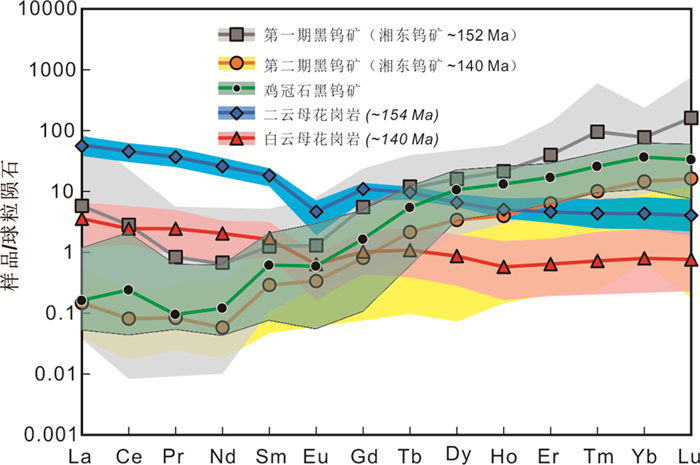
|
图 6 邓阜仙成矿花岗岩及黑钨矿球粒陨石标准化稀土配分曲线(标准化值据Sun and McDonough, 1989) 花岗岩和湘东钨矿黑钨矿数据引自Xiong et al., 2020a Fig. 6 Chondrite-normalized REE patterns for the Dengfuxian granites and wolframite (normalized value from Sun and McDonough, 1989) Data of granites and wolframite in the Xiangdong deposit from Xiong et al., 2020a |
黑钨矿中重要的微量元素Nb、Ta和Sc常以类质同象的形式赋存在黑钨矿晶格中,同时,它们含量的变化也能对黑钨矿的成因和形成环境提供重要的指示(Xiong et al., 2017; Harlaux et al., 2018)。前人通过多手段(显微镜、SEM等)岩相学观察、黑钨矿成分分析和实验岩石学模拟研究总结认为黑钨矿中的Nb、Ta和Sc含量主要是受黑钨矿形成时流体中F、Cl、CO2等挥发分和络合物的含量、pH及Eh的影响。富挥发分(F、Cl等)、低pH和高Eh环境有利于Nb和Ta在黑钨矿中的富集,而富挥发分和磷酸盐等络合物、低pH和低Eh环境则有利于Sc的富集(Tindle and Webb, 1989;干国梁和陈志雄,1991; Wood and Samson, 2006; Bychkov and Matveeva, 2008; Xiong et al., 2017)。鸡冠石钨矿床中黑钨矿(平均含量Nb:528×10-6;Ta:50×10-6;Sc:6×10-6)相对于沃溪矿床而言(平均含量Nb:0.42×10-6;Ta:0.03×10-6;Sc:117×10-6;祝亚男等,2014)明显富集Nb、Ta而贫Sc,可能说明鸡冠石矿床中的黑钨矿形成于一个富挥发分、低pH和高Eh的流体环境中,且成矿温度高于沃溪矿床。
此外,还有学者通过黑钨矿中Y/Ho和Zr/Hf的微量元素比值来判断其成因(祝亚男等,2014;Harlaux et al., 2018)。本文通过对比世界上典型钨矿集区中不同类型钨矿床(法国中央高原钨锡成矿带和我国南岭钨锡成矿带)的黑钨矿Y/Ho和Zr/Hf比值,发现鸡冠石矿床中的黑钨矿Y/Ho和Zr/Hf比值与湘东钨矿床中第一期黑钨矿特征吻合度高,但与大吉山钨矿床中黑钨矿微量元素特征相差较大(图 7)。Bau (1996)研究证实Y和Ho在流体与围岩反应过程中通常按球粒陨石中的比例进行迁移,当体系中Y与REE以F络合物为主时,Y/Ho比值大于28。总体而言,世界范围内大部分钨矿床都与高演化的花岗岩有关(Heinrich, 1990; Lehmann et al., 1990;陈骏等,2008;Romer and Kroner, 2016),且岩浆期后热液中通常富含F等挥发分。在黑钨矿Y/Ho和Zr/Hf投图中,仅大吉山钨矿床投点落入Y/Ho比值大于28范围,而法国中央高原地区与高分异花岗岩具有成因联系的钨矿床以及南岭地区湘东钨矿和鸡冠石钨矿床中的黑钨矿Y/Ho和Zr/Hf比值绝大部分均落在Y/Ho比值小于28范围内(图 7),而鸡冠石钨矿中出现的萤石和电气石,指示其为一个富F体系,与Bau(1996)研究成果不一致(以F络合物为主时,Y/Ho>28)。因此,通过黑钨矿Y/Ho和Zr/Hf的比值来判断其成因值得商榷,需要进一步的工作来证实。
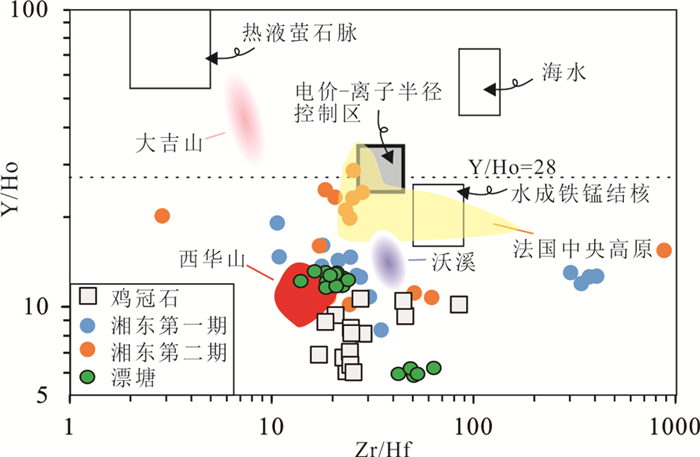
|
图 7 鸡冠石钨矿床黑钨矿Y/Ho-Zr/Hf图解(底图据Xiong et al., 2020a) 法国中央高原数据引自Harlaux et al., 2018;沃溪和大吉山钨矿数据祝亚男等,2014;西华山和漂塘钨矿数据引自Zhang et al., 2018 Fig. 7 Y/Ho vs. Zr/Hf ratios in wolframite from the Jiguanshi W deposit (base map after Xiong et al., 2020a) Data sources: the French Massif Central (Harlaux et al., 2018); Woxi and Dajishan tungsten deposits (Zhu et al., 2014); Xihuashan and Piaotang tungsten deposits (Zhang et al., 2018) |
(1) 与黑钨矿密切共生的锡石U-Pb定年结果指示鸡冠石钨矿床的形成时代为153.2±1.8Ma,成矿与晚侏罗世二云母花岗岩密切相关。
(2) 黑钨矿的微量元素特征指示鸡冠石矿床可能形成于一个富挥发分、低pH和高Eh的流体环境中。
致谢 野外工作得到湖南省四一六地质队伍式崇、朱浩峰和中南大学吴堑虹、孔华、言奇、程路平等的大力支持及帮助; 锡石定年工作得到了中国地质大学(武汉)张迪博士的大力支持; 审稿专家为论文的完善提出了宝贵的意见; 在此一并表示衷心的感谢!
Bau M. 1996. Controls on the fractionation of isovalent trace elements in magmatic and aqueous systems: Evidence from Y/Ho, Zr/Hf, and lanthanide tetrad effect. Contributions to Mineralogy and Petrology, 123(3): 323-333 DOI:10.1007/s004100050159
|
Bychkov AY and Matveeva SS. 2008. Thermodynamic model of the formation of ore bodies at the Akchatau wolframite greisen-vein deposit. Geochemistry International, 46(9): 867-886 DOI:10.1134/S0016702908090024
|
Cai Y, Ma DS, Lu JJ, Huang H, Zhang RQ and Qu WJ. 2012. Re-Os geochronology and S isotope geochemistry of Dengfuxian tungsten deposit, Hunan Province, China. Acta Petrologica Sinica, 28(12): 3798-3808 (in Chinese with English abstract)
|
Cai Y, Lu JJ, Ma DS, Huang H and Zhang HF. 2013. Chronology and geochemical characteristics of Late Indosinian Dengfuxian two-mica granite in eastern Hunan Province, China, and its significance. Acta Petrologica Sinica, 29(12): 4215-4231 (in Chinese with English abstract)
|
Cai Y, Lu JJ, Ma DS, Huang H, Zhang HF and Zhang RQ. 2015. The Late Triassic Dengfuxian A-type granite, Hunan Province: Age, petrogenesis, and implications for understanding the Late Indosinian tectonic transition in South China. International Geology Review, 57(4): 428-445 DOI:10.1080/00206814.2015.1012565
|
Cao HW, Zhang YH, Pei QM, Zhang RQ, Tang L, Lin B and Cai GJ. 2017. U-Pb dating of zircon and cassiterite from the Early Cretaceous Jiaojiguan iron-tin polymetallic deposit, implications for magmatism and metallogeny of the Tengchong area, western Yunnan, China. International Geology Review, 59(2): 234-258 DOI:10.1080/00206814.2016.1220842
|
Cao HW, Li GM, Zhang RQ, Zhang YH, Zhang LK, Dai ZW, Zhang Z, Liang W, Dong SL and Xia XB. 2021. Genesis of the Cuonadong tin polymetallic deposit in the Tethyan Himalaya: Evidence from geology, geochronology, fluid inclusions and multiple isotopes. Gondwana Research, 92: 72-101 DOI:10.1016/j.gr.2020.12.020
|
Chen J, Lu JJ, Chen WF, Wang RC, Ma DS, Zhu JC, Zhang WL and Ji JF. 2008. W-Sn-Nb-Ta-bearing granites in the Nanling range and their relationship to metallogengesis. Geological Journal of China Universities, 14(4): 459-473 (in Chinese with English abstract)
|
Fei GC, Menuge JF, Li YQ, Yang JY, Deng Y, Chen CS, Yang YF, Yang Z, Qin LY, Zheng L and Tang WC. 2020. Petrogenesis of the Lijiagou spodumene pegmatites in Songpan-Garze Fold Belt, West Sichuan, China: Evidence from geochemistry, zircon, cassiterite and coltan U-Pb geochronology and Hf isotopic compositions. Lithos, 364-365: 105555 DOI:10.1016/j.lithos.2020.105555
|
Gan GL and Chen ZX. 1991. The compositional characteristics and existing states of major, trace and rare-earth elements in wolframite from the Dupanling tin ore-field, Guangxi. Acta Mineralogica Sinica, (2): 122-132 (in Chinese with English abstract)
|
Goldmann S, Melcher F, Gäbler HE, Dewaele S, De Clercq F and Muchez P. 2013. Mineralogy and trace element chemistry of ferberite/reinite from tungsten deposits in central Rwanda. Minerals, 3(2): 121-144 DOI:10.3390/min3020121
|
Guo J, Zhang RQ, Li CY, Sun WD, Hu YB, Kang DM and Wu JD. 2018a. Genesis of the Gaosong Sn-Cu deposit, Gejiu district, SW China: Constraints from in situ LA-ICP-MS cassiterite U-Pb dating and trace element fingerprinting. Ore Geology Reviews, 92: 627-642 DOI:10.1016/j.oregeorev.2017.11.033
|
Guo J, Zhang RQ, Sun WD, Ling MX, Hu YB, Wu K, Luo M and Zhang LC. 2018b. Genesis of tin-dominant polymetallic deposits in the Dachang district, South China: Insights from cassiterite U-Pb ages and trace element compositions. Ore Geology Reviews, 95: 863-879 DOI:10.1016/j.oregeorev.2018.03.023
|
Harlaux M, Mercadier J, Marignac C, Peiffert C, Cloquet C and Cuney M. 2018. Tracing metal sources in peribatholitic hydrothermal W deposits based on the chemical composition of wolframite: The example of the Variscan French Massif Central. Chemical Geology, 479: 58-85 DOI:10.1016/j.chemgeo.2017.12.029
|
He M, Liu Q, Hou QL, Sun JF, Zhang JH, Wu SC and Zhu HF. 2018. Petrogenesis of the Dengfuxian granite, eastern Hunan Province and constraints on mineralization: Evidences from zircon and cassiterite U-Pb geochronology, zircon Hf-O isotopes and whole-rock geochemistry. Acta Petrologica Sinica, 34(3): 637-655 (in Chinese with English abstract)
|
Heinrich CA. 1990. The chemistry of hydrothermal tin (-tungsten) ore deposition. Economic Geology, 85(3): 457-481 DOI:10.2113/gsecongeo.85.3.457
|
Hu RZ and Zhou MF. 2012. Multiple Mesozoic mineralization events in South China: An introduction to the thematic issue. Mineralium Deposita, 47(6): 579-588 DOI:10.1007/s00126-012-0431-6
|
Hu RZ, Wei WF, Bi XW, Peng JT, Qi YQ, Wu LY and Chen YW. 2012a. Molybdenite Re-Os and muscovite 40Ar/39Ar dating of the Xihuashan tungsten deposit, central Nanling district, South China. Lithos, 150: 111-118 DOI:10.1016/j.lithos.2012.05.015
|
Hu RZ, Bi XW, Jiang GH, Chen HW, Peng JT, Qi YQ, Wu LY and Wei WF. 2012b. Mantle-derived noble gases in ore-forming fluids of the granite-related Yaogangxian tungsten deposit, southeastern China. Mineralium Deposita, 47(6): 623-632 DOI:10.1007/s00126-011-0396-x
|
Huang H, Ma DS, Lu JJ, Cai Y and Xie X. 2013. Zircon U-Pb geochronology and geochemistry characteristics of Dengfuxian two-mica granite, eastern Hunan Province, China. Acta Mineralogica Sinica, 33(2): 245-255 (in Chinese with English abstract)
|
Jiang SY, Wen HJ, Xu C, Wang Y, Su HM and Sun WD. 2019. Earth sphere cycling and enrichment mechanism of critical metals: Major scientific issues for future research. Bulletin of National Natural Science Foundation of China, 33(2): 112-118 (in Chinese with English abstract)
|
Jiang SY, Zhao KD, Jiang H, Su HM, Xiong SF, Xiong YQ, Xu YM, Zhang W and Zhu LY. 2020. Spatiotemporal distribution, geological characteristics and metallogenic mechanism of tungsten and tin deposits in China: An overview. Science Bulletin, 65(33): 3730-3745 (in Chinese)
|
Lehmann B, Ishihara S, Michel H, Miller J, Rapela C, Sanchez A, Tistl M and Winkelmann L. 1990. The Bolivian tin province and regional tin distribution in the Central Andes: A reassessment. Economic Geology, 85(5): 1044-1058 DOI:10.2113/gsecongeo.85.5.1044
|
Li CY, Zhang RQ, Ding X, Ling MX, Fan WM and Sun WD. 2016. Dating cassiterite using laser ablation ICP-MS. Ore Geology Reviews, 72: 313-322 DOI:10.1016/j.oregeorev.2015.07.016
|
Li H, Cao JY, Algeo TJ, Jiang WC, Liu B and Wu QH. 2019. Zircons reveal multi-stage genesis of the Xiangdong (Dengfuxian) tungsten deposit, South China. Ore Geology Reviews, 111: 102979 DOI:10.1016/j.oregeorev.2019.102979
|
Li H, Hong T, Yang ZQ, Chen JZ, Ke Q, Wang XH, Niu L and Xu XW. 2020. Comparative studying on zircon, cassiterite and coltan U-Pb dating and 40Ar/39Ar dating of muscovite rare-metal granitic pegmatites: A case study of the northern Tugeman lithium-beryllium deposit in the middle of Altyn Tagh. Acta Petrologica Sinica, 36(9): 2869-2892 (in Chinese with English abstract) DOI:10.18654/1000-0569/2020.09.16
|
Liu B, Wu JH, Li H, Wu QH, Evans NJ, Kong H and Xi XS. 2020a. Geochronology, geochemistry and petrogenesis of the Dengfuxian lamprophyres: Implications for the Early Cretaceous tectonic evolution of the South China Block. Geochemistry, 80(2): 125598 DOI:10.1016/j.chemer.2020.125598
|
Liu B, Wu Q, Li H, Wu J, Cao J, Jiang J and Liang W. 2020b. Fault-controlled fluid evolution in the Xitian W-Sn-Pb-Zn-fluorite mineralization system (South China): Insights from fluorite texture, geochemistry and geochronology. Ore Geology Reviews, 116: 103233 DOI:10.1016/j.oregeorev.2019.103233
|
Liu JY. 2003. Compound massif and complex massif: The two basic forms of the massif association of granitoid and their significance. Contributions To Geology and Mineral Resources Research, 18(3): 143-148 (in Chinese with English abstract)
|
Liu P, Mao JW, Santosh M, Xu LG, Zhang RQ and Jia LH. 2018. The Xiling Sn deposit, eastern Guangdong Province, southeast China: A new genetic model from 40Ar/39Ar muscovite and U-Pb cassiterite and zircon geochronology. Economic Geology, 113(2): 511-530 DOI:10.5382/econgeo.2018.4560
|
Liu YP, Li ZX, Li HM, Guo LG, Xu W, Ye L, Li CY and Pi DH. 2007. U-Pb geochronology of cassiterite and zircon from the Dulong Sn-Zn deposit: Evidence for Cretaceous large-scale granitic magmatism and mineralization events in southeastern Yunnan province, China. Acta Petrologica Sinica, 23(5): 967-976 (in Chinese with English abstract)
|
Ludwig KR. 2012. User's Manual for Isoplot Version 3.75-4.15: A Geochronological Toolkit for Microsoft Excel. Berkeley Geochronological Center Special Publication, 5: 1-56
|
Mao JW, Cheng YB, Chen MH and Pirajno F. 2013. Major types and time-space distribution of Mesozoic ore deposits in South China and their geodynamic settings. Mineralium Deposita, 48(3): 267-294 DOI:10.1007/s00126-012-0446-z
|
Mao JW, Ouyang HG, Song SW, Santosh M, Yuan SD, Zhou ZH, Zheng W, Liu H, Liu P, Cheng Y and Chen MH. 2020. Geology and metallogeny of tungsten and tin deposits in China. Society of Economic Geologists Special Publication, 22: 411-482
|
Mao JW, Wu SH, Song SW, Dai P, Xie GQ, Su QW, Liu P, Wang XG, Yu ZZ, Chen XY and Tang WX. 2020. The world-class Jiangnan tungsten belt: Geological characteristics, metallogeny, and ore deposit model. Science Bulletin, 65(33): 3746-3762 (in Chinese)
|
Mao JW, Zheng W, Xie GQ, Lehmann B and Goldfarb R. 2021. Recognition of a Middle-Late Jurassic arc-related porphyry copper belt along the southeast China coast: Geological characteristics and metallogenic implications. Geology DOI:10.1130/G48615.1
|
Qiu KF, Yu HC, Wu MQ, Geng JZ, Ge XK, Gou ZY and Taylor RD. 2019. Discrete Zr and REE mineralization of the Baerzhe rare-metal deposit, China. American Mineralogists, 104: 1487-1502 DOI:10.2138/am-2019-6890
|
Romer RL and Kroner U. 2016. Phanerozoic tin and tungsten mineralization: Tectonic controls on the distribution of enriched protoliths and heat sources for crustal melting. Gondwana Research, 31: 60-95 DOI:10.1016/j.gr.2015.11.002
|
Sheng JF, Chen ZH, Liu LJ, Ying LJ, Huang F, Wang DH, Wang JH and Zeng L. 2015. Outline of metallogeny of tungsten deposits in China. Acta Geologica Sinica, 89(6): 1038-1050 (in Chinese with English abstract)
|
Song GX, Qin KZ, Li GM, Evans NJ and Chen L. 2014. Scheelite elemental and isotopic signatures: Implications for the genesis of skarn-type W-Mo deposits in the Chizhou Area, Anhui Province, Eastern China. American Mineralogist, 99(2-3): 303-317 DOI:10.2138/am.2014.4431
|
Sun SS and McDonough WF. 1989. Chemical and isotopic systematics of oceanic basalts: Implications for mantle composition and processes. In: Saunders AD and Norry MJ (eds.). Magmatism in the Ocean Basins. Geological Society, London, Special Publications, 42(1): 313-345
|
Tera F and Wasserburg GJ. 1972. U-Th-Pb systematics in three Apollo 14 basalts and the problem of initial Pb in lunar rocks. Earth and Planetary Science Letters, 14(3): 281-304 DOI:10.1016/0012-821X(72)90128-8
|
Tindle AG and Webb PC. 1989. Niobian wolframite from Glen Gairn in the Eastern Highlands of Scotland: A microprobe investigation. Geochimica et Cosmochimica Acta, 53(8): 1921-1935 DOI:10.1016/0016-7037(89)90313-X
|
Wang XJ, Liu YP, Miao YL, Bao T, Ye L and Zhang Q. 2014. In-situ LA-MC-ICP-MS cassiterite U-Pb dating of Dulong Sn-Zn polymetallic deposit and its significance. Acta Petrologica Sinica, 30(3): 867-876 (in Chinese with English abstract)
|
Wei W, Song C, Hou QL, Chen Y, Faure M, Yan QR, Liu Q, Sun JF and Zhu HF. 2018. The Late Jurassic extensional event in the central part of the South China Block: Evidence from the Laoshan'ao shear zone and Xiangdong Tungsten deposit (Hunan, SE China). International Geology Review, 60(11-14): 1644-1664 DOI:10.1080/00206814.2017.1395714
|
Wood SA and Samson IM. 2006. The aqueous geochemistry of gallium, germanium, indium and scandium. Ore Geology Reviews, 28(1): 57-102 DOI:10.1016/j.oregeorev.2003.06.002
|
Xia QL, Wang XQ, Liu ZZ, Li TF and Feng L. 2018. Tungsten metallogenic and geological features and mineral resource potential in China. Earth Science Frontiers, 25(3): 50-58 (in Chinese with English abstract)
|
Xie GQ, Mao JW, Bagas L, Fu B and Zhang ZY. 2019. Mineralogy and titanite geochronology of the Caojiaba W deposit, Xiangzhong metallogenic province, southern China: Implications for a distal reduced skarn W formation. Mineralium Deposita, 54(3): 459-472 DOI:10.1007/s00126-018-0816-2
|
Xiong YQ, Shao YJ, Zhou HD, Wu QH, Liu JP, Wei HT, Zhao RC and Cao JY. 2017. Ore-forming mechanism of quartz-vein-type W-Sn deposits of the Xitian district in SE China: Implications from the trace element analysis of wolframite and investigation of fluid inclusions. Ore Geology Reviews, 83(c): 152-173
|
Xiong YQ, Shao YJ, Mao JW, Wu SC, Zhou HD and Zheng MH. 2019. The polymetallic magmatic-hydrothermal Xiangdong and Dalong systems in the W-Sn-Cu-Pb-Zn-Ag Dengfuxian orefield, SE China: Constraints from geology, fluid inclusions, H-O-S-Pb isotopes, and sphalerite Rb-Sr geochronology. Mineralium Deposita, 54(8): 1101-1124 DOI:10.1007/s00126-019-00863-x
|
Xiong YQ, Shao YJ, Cheng YB and Jiang SY. 2020a. Discrete Jurassic and Cretaceous mineralization events at the Xiangdong W(-Sn) deposit, Nanling Range, South China. Economic Geology, 115(2): 385-413 DOI:10.5382/econgeo.4704
|
Xiong YQ, Shao YJ, Jiang SY, Zhao DK and Yan Q. 2020b. Distal relationship of the Taihexian Pb-Zn-(Au) deposit to the Dengfuxian magmatic-hydrothermal system, South China: Constraints from mineralogy, fluid inclusion, H-O-Pb and in situ S isotopes. Ore Geology Reviews, 127: 103826 DOI:10.1016/j.oregeorev.2020.103826
|
Xiong YQ, Jiang SY, Wen CH and Yu HY. 2020c. Granite-pegmatite connection and mineralization age of the giant Renli Ta-Nb deposit in South China: Constraints from U-Th-Pb geochronology of coltan, monazite, and zircon. Lithos, 358-359: 105422 DOI:10.1016/j.lithos.2020.105422
|
Yang MG, Huang SB, Lou FS, Tang WX and Mao SB. 2009. Lithospheric structure and large-scale metallogenic process in Southeast China continental area. Geology in China, 36(3): 528-543 (in Chinese with English abstract)
|
Yuan SD, Peng JT, Hu RZ, Li HM, Shen NP and Zhang DL. 2008. A precise U-Pb age on cassiterite from the Xianghualing tin-polymetallic deposit (Hunan, South China). Mineralium Deposita, 43(4): 375-382 DOI:10.1007/s00126-007-0166-y
|
Yuan SD, Peng JT, Hao S, Li HM, Geng JZ and Zhang DL. 2011. In situ LA-MC-ICP-MS and ID-TIMS U-Pb geochronology of cassiterite in the giant Furong tin deposit, Hunan Province, South China: New constraints on the timing of tin-polymetallic mineralization. Ore Geology Reviews, 43(1): 235-242 DOI:10.1016/j.oregeorev.2011.08.002
|
Yuan SD, Zhang DL, Shuang Y, Du AD and Qu WJ. 2012. Re-Os dating of molybdenite from the Xintianling giant tungsten-molybdenum deposit in southern Hunan Province, China and its geological implications. Acta Petrologica Sinica, 28(1): 27-38 (in Chinese with English abstract)
|
Yuan SD, Mao JW, Cook NJ, Wang XD, Liu XF and Yuan YB. 2015. A Late Cretaceous tin metallogenic event in Nanling W-Sn metallogenic province: Constraints from U-Pb, Ar-Ar geochronology at the Jiepailing Sn-Be-F deposit, Hunan, China. Ore Geology Reviews, 65: 283-293 DOI:10.1016/j.oregeorev.2014.10.006
|
Yuan SD. 2017. Several crucial scientific issues related to the W-Sn metallogenesis in the Nanling range and their implications for regional exploration: A review. Bulletin of Mineralogy, Petrology and Geochemistry, 36(5): 736-749 (in Chinese with English abstract)
|
Yuan SD, Williams-Jones AE, Mao JW, Zhao PL, Yan C and Zhang DL. 2018. The origin of the Zhangjialong tungsten deposit, South China: Implications for W-Sn mineralization in large granite batholiths. Economic Geology, 113(5): 1193-1208 DOI:10.5382/econgeo.2018.4587
|
Yuan SD, Williams-Jones AE, Romer RL, Zhao PL and Mao JW. 2019. Protolith-related thermal controls on the decoupling of Sn and W in Sn-W metallogenic provinces: Insights from the Nanling Region, China. Economic Geology, 114(5): 1005-1012 DOI:10.5382/econgeo.4669
|
Zhai DG, Liu JJ, Zhang AL and Sun YQ. 2017. U-Pb, Re-Os, and 40Ar/39Ar geochronology of porphyry Sn±Cu±Mo and polymetallic (Ag-Pb-Zn-Cu) vein mineralization at Bianjiadayuan, Inner Mongolia, northeast China: Implications for discrete mineralization events. Economic Geology, 112(8): 2041-2059 DOI:10.5382/econgeo.2017.4540
|
Zhai MG, Wu FY, Hu RZ, Jiang SY, Li WC, Wang RC, Wang DH, Qi T, Qin KZ and Wen HJ. 2019. Critical metal mineral resources: Current research status and scientific issues. Bulletin of National Natural Science Foundation of China, 33(2): 106-111 (in Chinese with English abstract)
|
Zhang Q, Zhang RQ, Gao JF, Lu JJ and Wu JW. 2018. In-situ LA-ICP-MS trace element analyses of scheelite and wolframite: Constraints on the genesis of veinlet-disseminated and vein-type tungsten deposits, South China. Ore Geology Reviews, 99: 166-179 DOI:10.1016/j.oregeorev.2018.06.004
|
Zhang RQ, Lu JJ, Wang RC, Yang P, Zhu JC, Yao Y, Gao JF, Li C, Lei ZH, Zhang WL and Guo WM. 2015. Constraints of in situ zircon and cassiterite U-Pb, molybdenite Re-Os and muscovite 40Ar-39Ar ages on multiple generations of granitic magmatism and related W-Sn mineralization in the Wangxianling area, Nanling Range, South China. Ore Geology Reviews, 65: 1021-1042 DOI:10.1016/j.oregeorev.2014.09.021
|
Zhang RQ, Lehmann B, Seltmann R, Sun WD and Li CY. 2017a. Cassiterite U-Pb geochronology constrains magmatic-hydrothermal evolution in complex evolved granite systems: The classic Erzgebirge tin province (Saxony and Bohemia). Geology, 45(12): 1095-1098 DOI:10.1130/G39634.1
|
Zhang RQ, Lu JJ, Lehmann B, Li CY, Li GL, Zhang LP, Guo J and Sun WD. 2017b. Combined zircon and cassiterite U-Pb dating of the Piaotang granite-related tungsten-tin deposit, southern Jiangxi tungsten district, China. Ore Geology Reviews, 82: 268-284 DOI:10.1016/j.oregeorev.2016.10.039
|
Zhang W, Lentz DR, Thorne KG and Massawe RJR. 2020. Late Silurian-Early Devonian slab break-off beneath the Canadian Appalachians: Insights from the Nashwaak Granite, west-central New Brunswick, Canada. Lithos, 358-359: 105393 DOI:10.1016/j.lithos.2020.105393
|
Zhang Y, Shao YJ, Wu CD and Chen HY. 2017. LA-ICP-MS trace element geochemistry of garnets: Constraints on hydrothermal fluid evolution and genesis of the Xinqiao Cu-S-Fe-Au deposit, eastern China. Ore Geology Reviews, 86: 426-439 DOI:10.1016/j.oregeorev.2017.03.005
|
Zhao PL, Yuan SD, Mao JW, Yuan YB, Zhao HJ, Zhang DL and Shuang Y. 2018a. Constraints on the timing and genetic link of the large-scale accumulation of proximal W-Sn-Mo-Bi and distal Pb-Zn-Ag mineralization of the world-class Dongpo orefield, Nanling Range, South China. Ore Geology Reviews, 95: 1140-1160 DOI:10.1016/j.oregeorev.2017.12.005
|
Zhao WW, Zhou MF, Williams-Jones AE and Zhao Z. 2018b. Constraints on the uptake of REE by scheelite in the Baoshan tungsten skarn deposit, South China. Chemical Geology, 477: 123-136 DOI:10.1016/j.chemgeo.2017.12.020
|
Zhu YN, Peng JT, Liu SY and Sun YZ. 2014. Mineral deposit geology and trace element geochemistry of wolframite from the Woxi deposit, western Hunan, China. Geochimica, 43(3): 287-300 (in Chinese with English abstract)
|
蔡杨, 马东升, 陆建军, 黄卉, 章荣清, 屈文俊. 2012. 湖南邓阜仙钨矿辉钼矿铼-锇同位素定年及硫同位素地球化学研究. 岩石学报, 28(12): 3798-3808. |
蔡杨, 陆建军, 马东升, 黄卉, 张怀峰. 2013. 湖南邓阜仙印支晚期二云母花岗岩年代学、地球化学特征及其意义. 岩石学报, 29(12): 4215-4231. |
陈骏, 陆建军, 陈卫锋, 王汝成, 马东升, 朱金初, 张文兰, 季峻峰. 2008. 南岭地区钨锡铌钽花岗岩及其成矿作用. 高校地质学报, 14(4): 459-473. DOI:10.3969/j.issn.1006-7493.2008.04.001 |
干国梁, 陈志雄. 1991. 广西都庞岭地区锡矿床黑钨矿主要、微量及稀土元素的组成特点及赋存状态. 矿物学报, (2): 122-132. |
何苗, 刘庆, 侯泉林, 孙金凤, 张吉衡, 伍式崇, 朱浩锋. 2018. 湘东邓阜仙花岗岩成因及对成矿的制约: 锆石/锡石U-Pb年代学、锆石Hf-O同位素及全岩地球化学特征. 岩石学报, 34(3): 637-655. |
黄卉, 马东升, 陆建军, 蔡杨, 谢旭. 2013. 湘东邓阜仙二云母花岗岩锆石U-Pb年代学及地球化学研究. 矿物学报, 33(2): 245-255. |
蒋少涌, 温汉捷, 许成, 王焰, 苏慧敏, 孙卫东. 2019. 关键金属元素的多圈层循环与富集机理: 主要科学问题及未来研究方向. 中国科学基金, 33(2): 112-118. |
蒋少涌, 赵葵东, 姜海, 苏慧敏, 熊索菲, 熊伊曲, 徐耀明, 章伟, 朱律运. 2020. 中国钨锡矿床时空分布规律、地质特征与成矿机制研究进展. 科学通报, 65(33): 3730-3745. |
李杭, 洪涛, 杨智全, 陈建中, 柯强, 王学海, 牛磊, 徐兴旺. 2020. 稀有金属花岗伟晶岩锆石、锡石与铌钽铁矿U-Pb和白云母40Ar/39Ar测年对比研究――以阿尔金中段吐格曼北锂铍矿床为例. 岩石学报, 36(9): 2869-2892. |
刘家远. 2003. 复式岩体和杂岩体――花岗岩类岩体组合的两种基本形式及其意义. 地质找矿论丛, 18(3): 143-148. |
刘玉平, 李正祥, 李惠民, 郭利果, 徐伟, 叶霖, 李朝阳, 皮道会. 2007. 都龙锡锌矿床锡石和锆石U-Pb年代学: 滇东南白垩纪大规模花岗岩成岩-成矿事件. 岩石学报, 23(5): 967-976. |
毛景文, 吴胜华, 宋世伟, 戴盼, 谢桂青, 苏蔷薇, 刘鹏, 王先广, 余忠珍, 陈祥云, 唐维新. 2020. 江南世界级钨矿带: 地质特征、成矿规律和矿床模型. 科学通报, 65(33): 3746-3762. |
盛继福, 陈郑辉, 刘丽君, 应立娟, 黄凡, 王登红, 王家欢, 曾乐. 2015. 中国钨矿成矿规律概要. 地质学报, 89(6): 1038-1050. |
王小娟, 刘玉平, 缪应理, 鲍谈, 叶霖, 张乾. 2014. 都龙锡锌多金属矿床LA-MC-ICPMS锡石U-Pb测年及其意义. 岩石学报, 30(3): 867-876. |
夏庆霖, 汪新庆, 刘壮壮, 李童斐, 冯磊. 2018. 中国钨矿成矿地质特征与资源潜力分析. 地学前缘, 25(3): 50-58. |
杨明桂, 黄水保, 楼法生, 唐维新, 毛素斌. 2009. 中国东南陆区岩石圈结构与大规模成矿作用. 中国地质, 36(3): 528-543. |
袁顺达, 张东亮, 双燕, 杜安道, 屈文俊. 2012. 湘南新田岭大型钨钼矿床辉钼矿Re-Os同位素测年及其地质意义. 岩石学报, 28(1): 27-38. |
袁顺达. 2017. 南岭钨锡成矿作用几个关键科学问题及其对区域找矿勘查的启示. 矿物岩石地球化学通报, 36(5): 736-749. |
翟明国, 吴福元, 胡瑞忠, 蒋少涌, 李文昌, 王汝成, 王登红, 齐涛, 秦克章, 温汉捷. 2019. 战略性关键金属矿产资源: 现状与问题. 中国科学基金, 33(2): 106-111. |
祝亚男, 彭建堂, 刘升友, 孙玉珍. 2014. 湘西沃溪矿床中黑钨矿的地质特征及微量元素地球化学. 地球化学, 43(3): 287-300. |
 2021, Vol. 37
2021, Vol. 37

